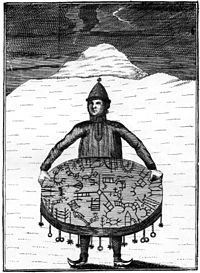Christianization of the Sámi people
This article may be expanded with text translated from the corresponding article in Swedish. (April 2021) Click [show] for important translation instructions.
|

The Christianization of the Sámi people in Norway and Sweden–Finland took place in stages during a several centuries long process. The Sámi were Christianized in a similar way in both Norway and Sweden–Finland.
Background - Christianity presence[]
There were Christian missionaries in Sápmi already during the Roman Catholic middle ages, and Christianity co-existed with traditional Sámi shamanism.
It was however not until the 17th-century, when the kingdoms of Norway and Sweden–Finland started to expand and colonize the Sápmi, that Christianity truly made its presence known.
Christianization by coercion[]
The Christian church were hostile to the Sámi shamanism, which it considered to be Pagan idolatry, and wished to exterminate it and Christianize the Sámi people in parallel with the royal powers wishing to assert their political dominance over the territory and use its economic resources. In the first half of the 17th-century, churches were built in Sápmi by the order of king Charles IX of Sweden, and the Sámi people were compelled to subject themselves to the law of Sweden–Finland by attending them.[1]
They were however silently allowed to practice Sámi shamanism in private until the second half of the 17th-century, when Swedish authorities forced them to abandon their religion, burning their Sámi drums, banning the joik singing and forced them to subject to the doctrine of the church both in public and private.[2]
Conversion in practice[]
The Sámi people still continued to practice Sámi shamanism in secrecy until the second half of the 18th-century, when missionaries of first the Pietism and then eventually the Laestadianism sect had true success in their mission and the Sámi people converted to Christianity.[2]
See also[]
References[]
- Henrysson, Sten, Samer, präster och skolmästare: ett kulturellt perspektiv på samernas och Övre Norrlands historia, Centrum för arktisk forskning, Univ., Umeå, 1993
- Christianization of Europe
- Persecution of Pagans
- Sámi history
- Persecution of Sámi people
- 17th century in Sweden